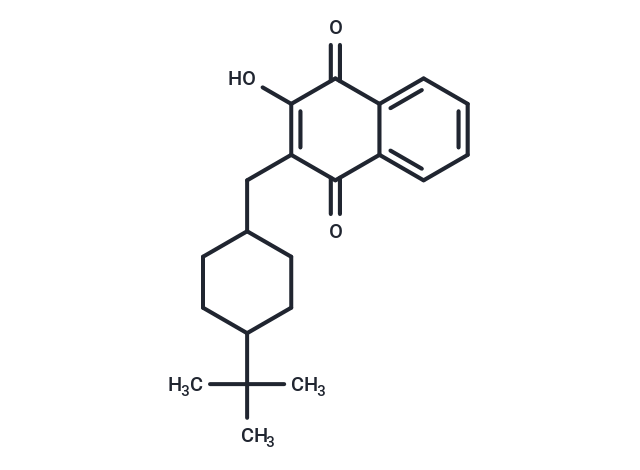Shopping Cart
- Remove All
 Your shopping cart is currently empty
Your shopping cart is currently empty

Buparvaquone (BW 720C) is a hydroxynaphthoquinone antiprotozoal drug related to atovaquone and parvaquone.

| Pack Size | Price | Availability | Quantity |
|---|---|---|---|
| 10 mg | $42 | In Stock | |
| 50 mg | $58 | In Stock | |
| 100 mg | $74 | In Stock |
| Description | Buparvaquone (BW 720C) is a hydroxynaphthoquinone antiprotozoal drug related to atovaquone and parvaquone. |
| In vitro | Buparvaquone is significantly selective against L. (L.) infantum chagasi intracellular amastigotes, with an IC50 value of 1.5 μM. In 4-day proliferation assays, buparvaquone efficiently inhibits N.?caninum tachyzoite replication(IC50=4.9?nM; IC100=100?nM). Other cutaneous species are also susceptible to buparvaquone, with IC50 values in the range 1-4 μM. |
| In vivo | Both a hydrous gel and a water-in-oil emulsion containing buparvaquone markedly decrease the cutaneous parasite load and lesion size compared to the untreated control. Administering buparvaquone (100 mg/kg) to N. caninum-infected mice, either through intraperitoneal injection or orally via gavage, effectively prevents neosporosis symptoms in a significant proportion of the subjects. Specifically, symptoms were prevented in four out of six mice in the group treated intraperitoneally and in six out of seven mice receiving oral treatment. |
| Cell Research | To study whether pretreatment of host cells prior to invasion had any effect on parasite proliferation, confluent HFF grown in 6-well plates are treated with 1?μM buparvaquone in medium for 1?h or 5?h, and controls are exposed to the corresponding amounts of DMSO. Subsequently, the drug-containing medium is removed and monolayers are ished 4 times with Hank's Balanced Salt Solution, and are infected with Nc-Liv tachyzoites in 5?mL medium without any drug or solvent. After 2 days, cells are collected with a cell scraper, centrifuged, ished once more in PBS, and the pellet is stored at ?20?°C prior to quantification of N.?caninum proliferation by N.?caninum-specific real time PCR as outlined below. |
| Animal Research | Mice: On day 0, all mice are infected by intraperitoneal (i.p.) injection of freshly purified N.?caninum tachyzoites. After 48?h, mice receive BPQ (100?mg/kg) as suspension in corn oil either by i.p. injection of a volume of 100?μl or by oral application of 100?μl by gavage. The control groups obtained the corresponding amount of the solvent only, either i.p. or orally. The treatments are performed 5 times on a daily basis. If not indicated otherwise, mice are inspected twice daily for clinical signs (ruffled coat, apathy, hind limb paralysis) until day 21 post infection (p.i.), at which time they are euthanized. |
| Alias | BW 720C, Butalex |
| Molecular Weight | 326.43 |
| Formula | C21H26O3 |
| Cas No. | 88426-33-9 |
| Smiles | O=C1C=2C(C(=O)C(O)=C1CC3CCC(C(C)(C)C)CC3)=CC=CC2 |
| Relative Density. | 1.158g/cm3 |
| Storage | Powder: -20°C for 3 years | In solvent: -80°C for 1 year | Shipping with blue ice. | ||||||||||||||||||||
| Solubility Information | DMSO: 3.26 mg/mL (10 mM), Sonication is recommended. | ||||||||||||||||||||
Solution Preparation Table | |||||||||||||||||||||
DMSO
| |||||||||||||||||||||

Copyright © 2015-2025 TargetMol Chemicals Inc. All Rights Reserved.